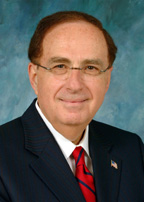 UNMC Chancellor Harold M. Maurer, M.D., has been named the recipient of the Lifetime Achievement Award of the Children’s Oncology Group, a National Cancer Institute-supported clinical cooperative cancer treatment and research group.
UNMC Chancellor Harold M. Maurer, M.D., has been named the recipient of the Lifetime Achievement Award of the Children’s Oncology Group, a National Cancer Institute-supported clinical cooperative cancer treatment and research group.
“I’m tremendously honored and humbled,” Dr. Maurer said. “To get a Lifetime Achievement Award from all of your peers in the United States, it actually makes me tremble a little bit. It’s the greatest kind of recognition that a physician could receive.”
Leading expert in the field
Dr. Maurer is being recognized for his significant contributions to pediatric cancer research, specifically his work with the Intergroup Rhabdomyosarcoma Study Group, which he helped to form in 1972. He chaired the group for the next 25 years, becoming the world’s foremost expert on the disease. The IRSG is credited with raising the cure rate of children afflicted with the disease from 20 percent to 75 percent.
“When I began my career, there was no literature about how to effectively treat rhabdomyosarcoma,” Dr. Maurer said. “All of the treatments were very radical, and we basically said, ‘Time out. There’s got to be a more effective way of treating children with this disease.’ As is turned out, there was.”
What is rhabdomyosarcoma?
Rhabdomyosarcoma is a malignant tumor found in soft tissue of children. The most common sites are the structures of the head and neck, the urogenital tract, and the arms or legs, but the cancer can form almost anywhere. Each body site, when afflicted with the cancer, has its own special problems, Dr. Maurer said. The cause of rhabdomyosarcoma is unknown. The vast majority of children with the disease do not have any known risk factors. With several hundred new cases per year throughout the United States, the cancer is the fifth-most common cancer found in children under age 15.
Working with patients
Dr. Maurer was a young physician-scientist at the Medical College of Virginia in Richmond when he diagnosed a young girl with rhabdomyosarcoma in her leg and in her lung. The standard treatment at that time was to amputate her leg and to surgically remove a portion of her lung. Instead, Dr. Maurer irradiated the tumor in the lung, resected the tumor from the girl’s leg, irradiated the post-operative tumor bed and proceeded with a novel chemotherapy regimen.
“She did real well,” Dr. Maurer said.
Still, the lack of any literature on rhabdomyosarcoma and the radical treatment that disfigured many children bothered Dr. Maurer. He wanted to form a study group, but needed more cases than were available regionally. Eventually, his idea of a study group made it to Denman Hammond, M.D., a professor at the University of California, Los Angeles, and a key clinical researcher for the National Cancer Institute (NCI).
Forming study groups
At a meeting in Park City, Utah, Dr. Maurer and several other physician-scientists met with Dr. Hammond to discuss study groups in rhabdomyosarcoma and three other childhood cancers. The rhabdomyosarcoma group was the only one to survive more than five years.
In 1972, with funding from the NCI, the Intergroup Rhabdomyosarcoma Study Committee (it would be formally become an NCI-recognized group in the early 1990s) launched its first integrative study, the first of four, six-year studies that the group would conduct over the next 25 years. The historical results were not good: only 20 percent of children who were afflicted with the disease in the United States survived.
Over the next two decades, however, that number increased to 75 percent, as hospitals around the country and world began to treat patients based on the research from the rhabdomyosarcoma study group.
“It became the gold standard of treatment,” Dr. Maurer said.
Bettering the treatment of patients
Dr. Maurer credits the work of the group for bettering the treatment of rhabdomyosarcoma patients. He said that team members wrote dozens upon dozens of papers and presented hundreds of lectures and seminars, never worrying about who was getting the credit.
Dr. Maurer himself is author of more than 200 publications and is the editor of a pediatrics textbook and a book on rhabdomyosarcoma. He also has presented at more than 150 scientific meetings and has served on the editorial boards of the American Journal of Hematology, the Journal of Pediatric Hematology and Oncology, and the Medical and Pediatric Oncology Journal.
Goal: helping children
In 1993, when he came to UNMC as the College of Medicine dean, Dr. Maurer brought nearly $1 million a year in National Institutes of Health grant money, relating to his research into rhabdomyosarcoma. He stepped down as chairman of the study group in 1998. The study group eventually became part of the Children’s Oncology Group when all children’s cancer study groups in the United States were combined.
“This award isn’t about what I’ve done, but what the people on my team have done all over the world,” Dr. Maurer said. “They didn’t care who got the credit, they just wanted children with this terrible disease to be treated better and to have better lives. I am glad that in most cases, we were able to achieve that.”